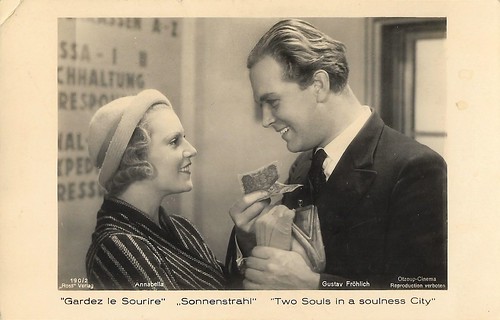
German postcard by Ross Verlag, no. 190/4. Photo: Otzoup Cinema. Annabella and Gustav Fröhlich in the Austrian film Sonnenstrahl/Gardez le sourire/Two Souls in a Soulless City (Pål Fejös, 1933).

German postcard by Ross Verlag, no. 7877/2, 1932-1933. Photo: Cinema / Willinger, Wien. Gustav Fröhlich and Annabella in Sonnenstrahl/Two Souls in a Soulless City (Paul Fejos, 1933).

German postcard by Ross Verlag, no. 190/3. Photo: Otzoup Cinema. Annabella and Gustav Fröhlich in the Austrian film Sonnenstrahl/Gardez le sourire/Two Souls in a Soulless City (Pål Fejös, 1933).
Rescued from the Danube
Vienna, at the height of the Great Depression. Like so many others, Hans Schmidt (Gustav Fröhlich) has no work, no money, and nowhere to live. Having lost his job as a taxi driver, he decides that the only solution is to kill himself. But just as he is about to drown himself in the Donau (Danube), he sees a young woman dive into the river, obviously with the same intention. Without a thought, Hans pulls the woman out of the water and does his best to comfort her.
Her name is Anna (Annabella) and she is only 18, but like Hans, she no longer has the strength to go on living. A little later, Hans and Anna think that together they can better cope with the misery and decide to master everyday life with all its shortcomings and worries. Hans receives money from the police for his rescue, which is immediately invested in the purchase of soap, which is sold on the street in small pieces for a profit.
Other small odd jobs - he makes himself available as a living target in a Prater booth and serves as an advertising sandwich man, she sells balloons and regularly has her head lathered to advertise a shampoo in the shop window - provide the couple with a modest financial cushion and thus the first ray of sunshine in both of their lives, which are marked by deprivation.
But there are also setbacks; for example, when a deposit of 200 shillings is paid for a prospective caretaker's job and the person taking the deposit turns out to be a crook. But Hans is no longer prepared to give up. He gets himself and Anna back on their feet and works as a bank messenger. Finally, the couple takes out a loan to buy a car, which will enable Hans to earn money as a taxi driver again in the future.
But a serious accident, which condemns Hans to inability to work for weeks, seems to set both their economic fortunes back again. Anna alone cannot pay off the loan instalments on the taxi, but in this emergency situation, the flatmates in the tenement prove to be in solidarity and help the couple with their nest eggs so that the vehicle can be paid off. Released from the hospital, Hans can finally earn money with his own taxi.

Dutch postcard by City Film, no. 496. Annabella and Gustav Fröhlich in Sonnenstrahl/Two Souls in a Soulless City (Pál Fejös, 1933). In the Netherlands, the film probably premiered in December 1933 at the Rotterdam-based art house Studio '32, part of the Tuschinski cinema chain.

Dutch postcard by City Film, no. 512. Annabella and Gustav Fröhlich in the Austrian film Sonnenstrahl/Ray of Sunlight (Pål Fejös, 1933).

German postcard. Publicity card for the film Sonnenstrahl at the Ufa-Theater, Turmstrasse, where the was shown from Friday 22 September (1933). Photo: Serge Otzoup-Filmproduktion / Tobis / Sascha. Annabella and Gustav Fröhlich in the German-Austrian film Sonnenstrahl/Two Souls in a Soulless City (Paul Fejos / Pál Fejös, 1933).
Characters that are as fragile as they are tough and resourceful
The Austrian-French film Sonnenstrahl/Gardez le sourire/Ray of Sunlight a.k.a. Two Souls in a Soulness City (1933) is a typical example of the work of the Hungarian-born filmmaker Pál Fejös (1897-1963). During the 1920s and 1930s, he was well-regarded internationally for his distinctive, humanist films. After World War I, he started to direct films for Mobil Studios in Hungary until he escaped in 1923 to flee the White Terror and the Horthy regime.
He moved to Hollywood where he made such films as The Last Moment (1928) with Georgia Hale, Lonesome (1928), The Last Performance (1929) with Conrad Veidt, and Broadway (1929) with Evelyn Brent. Fejös returned to Europe in 1931. In France, he directed the remak Fantômas/Fantomas (1932) starring Jean Galland. From the mid-1930s on he started to make documentaries. In 1941 he stopped making films altogether and became the Director of Research and the acting head of the Viking Fund.
Sonnenstrahl was made in Austria in two alternate language versions with the same leads. The French version, Gardez le sourire (1933), was co-directed with René Sti. With the exception of the two main actors, all the actors were different (= French) than in the Austrian original. The film was made in the Sascha film studio in Vienna-Sievering. Previously, Annabella had played a lead role in Fejös's film Prima dragoste/Marie, légende hongroise/First Love (Pál Fejös, Jean Mihail, 1933).
James Travers at French Films: "Annabella and Fröhlich both have a rare aptitude for playing characters that are as fragile as they are tough and resourceful, and so they are suitably paired in a film that plays on these qualities." Sonnnenstrahl/Ray of Sunlight (1933) premiered in Berlin's Gloria-Palast on 23 August 1933. In Vienna, the film was released on 15 December 1933.
"Writer-Director Paul Fejos (Pál Fejös) offers us a charming view of Vienna from the underside, with leads Annabella and Gustav Fröhlich most charming", writes Bob Lipton at IMDb: "The ups and downs go on a little too often. I would have cut it one iteration short, but he directs it as a silent with enough sound sequences to let you know this is the sound era. The leads mime their performances very nicely. Annabella is almost mute (perhaps her German was not so good) in her shy, mousy role and Fröhlich's performance suggests Bill Haines in one of his more down-to-earth roles. Anyone who has seen Fejos' Lonesome will recognize this as another film in the same vein, a corrective to King Vidor's The Crowd (1928). Between the players and the city of Vienna, this is a good one to see."

German postcard by Ross Verlag, no. 190/2. Photo: Otzoup Cinema. Annabella and Gustav Fröhlich in Sonnenstrahl/Two Souls in a Soulness City (Pål Fejös, 1933).

Dutch postcard by Filma, no. 537. Gustav Fröhlich and Annabella in Sonnenstrahl (Paul Fejos, 1933).
Sources: Bob Lipton (IMDb), James Travers (French Films), Wikipedia (German and English), and IMDb.
No comments:
Post a Comment